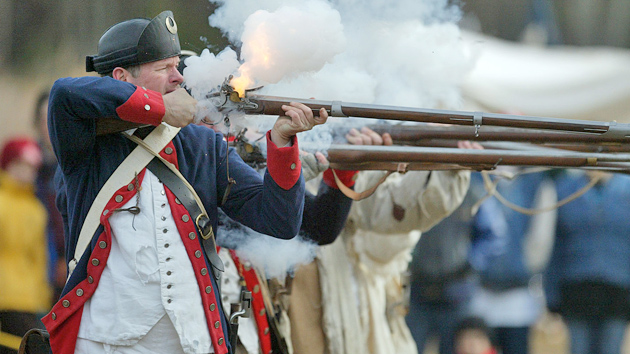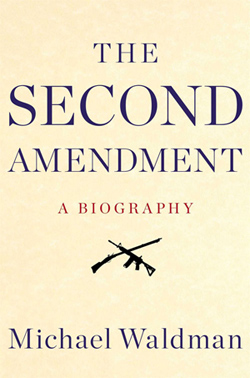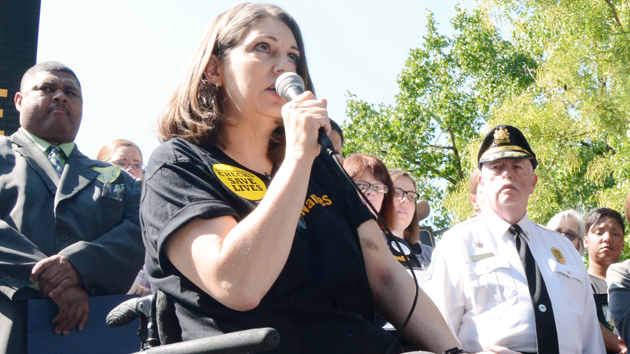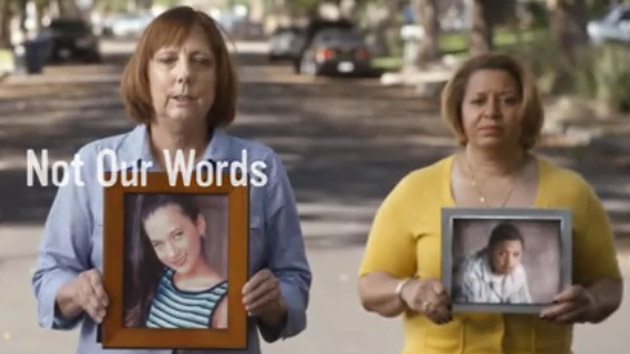
"To the framers, that phrase 'a well-regulated militia' was really critical," says Michael Waldman.The Shelby Star/Jeff Melton/AP
Less than a month after the December 2012 Newtown massacre, the National Rifle Association’s then-president, David Keene, warned that the new White House task force on gun violence would “do everything they can to strip Americans of their right to keep and bear arms, to essentially make the Second Amendment meaningless.” Three weeks ago, after a killer shot three people and wounded eight near Santa Barbara, California, conservative activist “Joe the Plumber” posted an open letter to the victims’ families. “Your dead kids,” he wrote, “don’t trump my Constitutional rights.”*

As America grapples with a relentless tide of gun violence, pro-gun activists have come to rely on the Second Amendment as their trusty shield when faced with mass-shooting-induced criticism. In their interpretation, the amendment guarantees an individual right to bear arms—a reading that was upheld by the Supreme Court in its 2008 ruling in District of Columbia. v. Heller. Yet most judges and scholars who debated the clause’s awkwardly worded and oddly punctuated 27 words in the decades before Heller almost always arrived at the opposite conclusion, finding that the amendment protects gun ownership for purposes of military duty and collective security. It was drafted, after all, in the first years of post-colonial America, an era of scrappy citizen militias where the idea of a standing army—like that of the just-expelled British—evoked deep mistrust.
In his new book, The Second Amendment: A Biography, Michael Waldman, president of the Brennan Center for Justice at New York University, digs into this discrepancy. What does the Second Amendment mean today, and what has it meant over time? He traces the history of the contentious clause and the legal reasoning behind it, from the Constitutional Convention to modern courtrooms.
This historical approach is noteworthy. The Heller decision, written by Justice Antonin Scalia, is rooted in originalism, the concept that the Constitution should be interpreted based on the original intent of the founders. While Waldman emphasizes that we must understand what the framers thought, he argues that giving them the last word is impossible—and impractical. “We’re not going to be able to go back in a time machine and tap James Madison on the shoulder and ask him what to do,” he says. “How the country has evolved is important. What the country needs now is important. That’s certainly the case with something as important and complicated as guns in America.”
Mother Jones: What inspired you to write this book?
Michael Waldman: I started the book after Newtown. There was such anguish about gun violence and we were debating, once again, what to do about it. But this was the first time we were having that conversation in the context of a Supreme Court ruling that the Second Amendment protects individual rights of gun owners. And now every time people debated guns, every time people talked about Newtown, they talked about the Second Amendment. I wanted to see what the real story was: What the amendment had meant over the years, and what we could learn from that.
MJ: What preconceived notions about the Second Amendment did the history that you uncovered confirm or debunk?
MW: There are surprises in this book for people who support gun control, and people who are for gun rights. When the Supreme Court ruled in Heller, Justice Scalia said he was following his doctrine of originalism. But when you actually go back and look at the debate that went into drafting of the amendment, you can squint and look really hard, but there’s simply no evidence of it being about individual gun ownership for self-protection or for hunting. Emphatically, the focus was on the militias. To the framers, that phrase “a well-regulated militia” was really critical. In the debates, in James Madison’s notes of the Constitutional Convention, on the floor of the House of Representatives as they wrote the Second Amendment, all the focus was about the militias. Now at the same time, those militias are not the National Guard. Every adult man, and eventually every adult white man, was required to be in the militias and was required to own a gun, and to bring it from home. So it was an individual right to fulfill the duty to serve in the militias.
MJ: You point out that the NRA has the Second Amendment inscribed in their lobby, but with the militia clause removed.
MW: Yes. That was first reported in an article in Mother Jones in the ’90s. But I didn’t want to rely on just that, so one of my colleagues went out to the NRA headquarters to look at the lobby. And she had her picture taken in front of the sign so we could confirm that it was actually still there!
MJ: Based on the history you’ve uncovered, do you think the founders understood there to be an unwritten individual right to arms that they didn’t include in the Constitution?
MW: Yes. And that might be noteworthy for some. There were plenty of guns. There was the right to defend yourself, which was part of English common law handed down from England. But there were also gun restrictions at the same time. There were many. There were limits, for example, on where you could store gunpowder. You couldn’t have a loaded gun in your house in Boston. There were lots of limits on who could own guns for all different kinds of reasons. There was an expectation that you should be able to own a gun. But they didn’t think they were writing that expectation into the Constitution with the Second Amendment.
MJ: So then why focus on the Second Amendment and not the English Bill of Rights or other things the framers drew on that more clearly address individual gun ownership?
MW: We are not governed today, in 2014, by British common law. Law evolved, the country evolved. It was a very rural place. There were no cities. There were no police forces. It was a completely different way of living. So gun rights activists turned this into a constitutional crusade. Those who want more guns and fewer restrictions realized they could gain some higher ground if they claimed the Constitution.
MJ: You write that throughout most of the 20th century, the courts stayed out of the gun laws debate. What changed that led them back in?
MW: What changed was the NRA. In 1991, former Chief Justice Warren Burger said that the idea that the Second Amendment recognizes an individual right to gun ownership was “a fraud” on the public. That was the consensus, that was the conventional wisdom.*
The NRA has been around for a long time. It used to be an organization that focused on hunters and on training. In 1977, at the NRA’s annual meeting, activists pushed out the leadership and installed new leaders who were very intense, very dogmatic, and very focused on the Second Amendment as their cause. It was called the “Revolt at Cincinnati.” From there, the NRA and its allies waged a 30-year legal campaign to change the way the courts and the country saw the Second Amendment. And they started with scholarship. They supported a lot of scholars and law professors. They elected politicians. They changed the positions of agencies of government. They got the Justice Department to reverse its position on what the amendment meant. And then and only then did they go to court. So by the time the Supreme Court ruled, it sort of felt like a ripe apple from the tree.
They also moved public opinion. Now it’s a pretty widely held view that it’s an individual right. It’s funny, I was just on a panel with Alan Gura, who argued the Heller case. And, you know, I gave him credit for being part of a really significant effort that changed the way we see the Constitution. What’s funny is that he and other gun rights people deny it! They say, “No, this is what everyone thought all along, for 200-plus years.”
MJ: What was the impact of the NRA’s sponsorship of Second Amendment legal scholarship?
MW: They certainly supported a lot of it. The way it works in constitutional law is that legal scholarship plays a pretty big role. So there became a rather deafening roar of the pro-individual gun ownership model: They were publishing and reinforcing each other. Some of it was very useful, and I cite it in the book. And some of it, when you look at some of the claims, they are easily punctured. It reminded me of the people who write movie posters, in terms of pulling quotes out of context. Like this Thomas Jefferson quote—”One loves to possess arms.” It is in serious law review articles. It’s presented as proof of what the founders really meant. But what happened was Thomas Jefferson wrote a letter to George Washington, saying, “Remember I sent you a bunch of those letters from when I was Secretary of State? Could you send them back to me? I think I’m going to get attacked for this position I made. I want to be able to defend myself: ‘One loves to possess arms,’ even though one hopes not to use them.” It’s a metaphor! But it’s in these law review articles. It’s funny! When you go to the NRA website, it’s still there. You can buy a T-shirt that has the quote!

MJ: How is it that such questionable scholarship went so far—all the way to the Supreme Court?
MW: You’ll have to ask the Supreme Court. The thing about the Heller decision that was especially concerning to me was that Justice Scalia said this was the “vindication” of his approach of originalism. But when it actually came time to doing the history, he skipped over the actual writing and purpose of the Second Amendment. Out of 64 pages [in the decision], only 2 deal with the militias. Which is what the founders thought they were talking about. One of the things that I hope people take away from this is that the original meaning is always important, but it is not the only way to interpret the Constitution.
MJ: What are your thoughts on the historical argument that the Second Amendment is a civil right protected under the 14th Amendment?
MW: After the Civil War, there were a lot of freed slaves who were terrorized by white vigilantes. One of the purposes of some of the framers of the 14th Amendment was to make sure that they get guns. Now, the Reconstruction government that enforced the 14th Amendment also had very strong gun laws, such as prohibitions on carrying concealed weapons. Just like the colonial period and the early revolutionary period, it was a very different time. What you had in the South was low-grade guerrilla warfare between the races. It’s hard to draw the lesson of what we should do now, in our urban society where assault weapons are available for sale, from the Reconstruction era.
MJ: You write that in Heller, there was a big shift in how the case was argued: There were many references to colonial America, and very little about current gun laws and current patterns of violence. Is this the new normal for gun cases?
MW: This is the triumph, in some ways, of originalism—Justice Scalia’s intellectual triumph in changing the way people make arguments in front of the Supreme Court. And yes, there are some other cases where it’s been pretty common. What’s interesting is that since Heller, there have been dozens of cases in lower courts. Heller said: Yes, there is an individual right, but it can be limited. And the extent of the limits wasn’t really clear. Well, dozens of judges have ruled since then, and overwhelmingly, they have upheld district gun laws. They’ve said, “Yes, there’s an individual right, but society, too, has a right to protect itself.” So maybe Heller‘s importance is not so great. And as this judicial consensus has developed across the country to uphold gun laws, we haven’t yet heard from the Supreme Court one more time. So I think the Supreme Court isn’t done yet.
Correction: An earlier version of this article included an incorrect quote from NRA executive vice president Wayne La Pierre.
Correction: An earlier version of this article misspelled Chief Justice Warren Burger’s last name.

















